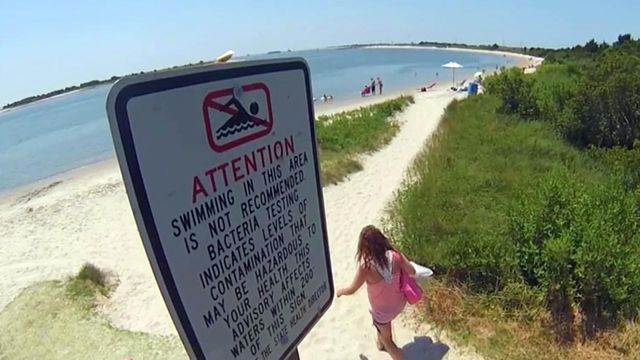Some coastal swimming spots fail water quality standards
Lauren Deaton was enjoying a day at the beach with her daughter when she saw a man testing the water. She soon learned that the man was a state inspector, and what he found wasn't good.
Posted — UpdatedRadio Island beach, where Deaton and her daughter were playing, is the state’s biggest trouble spot when it comes to water quality. In a recent test, the water had at least 20 times the recommended level for the bacteria enterococcus.
“It made me want to get out of the water,” Deaton said. “I didn’t want to swim anymore.”
Storm water runoff from agricultural and urban areas can deliver pathogens from humans, livestock, wildlife and pets into recreational waters. Poorly treated wastewater from treatment plants, malfunctioning septic systems and boat discharges can be sources of human fecal contamination. Bacteria can also be introduced directly into the bathing area from swimmers.
Budget cuts scale back water testing
Some of the sites that were cut included parts of the Albemarle and Currituck sounds and the upper Pungo and Neuse rivers.
Once samples are collected, they're taken to one of three state-run laboratories to test for bacteria. The water is diluted, a chemical reactant is added and the samples are sealed and incubated. After 24 hours, the samples with too much bacteria glow. Potts then decides if the bacteria levels are unsafe.
Water quality advisories posted in 2015
“Some people see (the advisories) and not get in the water. Some people see it and still get in the water,” Potts said. “Younger kids are probably more susceptible because they stay in the water longer and keep their head underwater for a much longer time.”
While Potts encourages swimmers to follow advisories, he doesn't want them to keep people from enjoying North Carolina's beauty.
“We do have excellent water quality down here at the coast. So, just because they see the signs doesn’t mean they can’t come down here and find other places where there’s pristine water quality,” he said.
As of Monday, there were no swimming advisories on the coast. Radio Island's last failed test was June 22. All high-use swimming spots are tested at least weekly from April to September. The testing even continues year-round- just not as frequently.
Choose swimming areas carefully
- Pay attention to signage and avoid swimming in coastal waters that are under a swimming advisory and in inland waters that have been closed or under advisory because of pollution or other risks.
- Do not swim or play in stagnant water or water with dead fish or algae in it.
- Do not swim or play in natural waters immediately after a heavy rain, as contaminants in the surrounding area may have washed into the water.
- Do not swim or play in waters near sewer pipes, discharge pipes, or storm drain outlets.
- Do not swim in water that is also frequented by livestock or other land animals.
Take simple precautions
- Avoid getting the water in your mouth, and do not drink or swallow the water.
- Reduce the risk of water going up your nose by holding your nose shut or using nose clips when taking part in water-related activities in bodies of warm freshwater such as lakes, rivers, or hot springs.
- Avoid digging in or stirring up the sediment while taking part in water-related activities in shallow, warm freshwater areas.
- Do not swim in natural waters, whether fresh or salt water, if you have open wounds or sores.
- Shower with soap and water after swimming or playing in the water.
- Promptly tend to any wounds, cuts or abrasions you get while in or near the water: thoroughly wash the wound with clean, potable water and soap, and seek a doctor’s care if a rash or swelling develops around the wound or it appears infected.
- Seek a doctor’s care immediately if you become ill or develop symptoms of an infection.
Prevent spread of illness to others
- Shower with soap before entering the water.
- Don’t swim if you have diarrhea.
- Change children’s diapers frequently, and dispose of soiled diapers in appropriate trash receptacles.
• Credits
Copyright 2024 by Capitol Broadcasting Company. All rights reserved. This material may not be published, broadcast, rewritten or redistributed.





